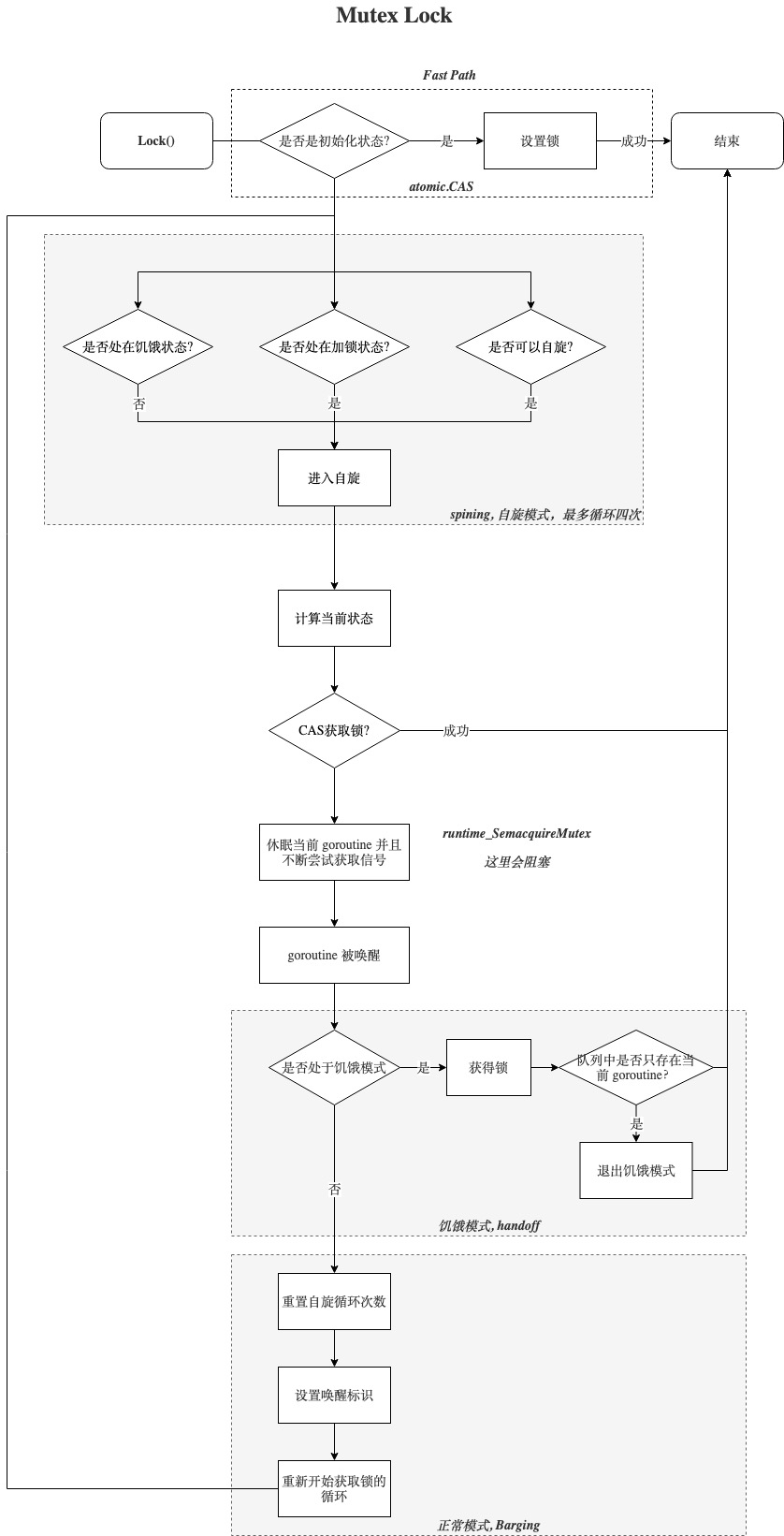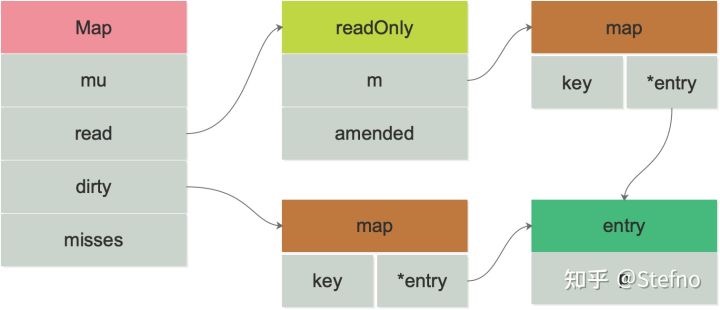Does one assembler instruction always execute atomically? [duplicate]
多图详解Go的互斥锁Mutex
Go并发编程(四) 深入理解 Mutex
【golang】sync.Mutex互斥锁的实现原理
go 读写锁实现原理解读
Semaphores in Process Synchronization
Lecture 6: architectural support for synchronization
详解go中的混合锁 - mutex
源码解读 Golang 的 sync.Map 实现原理
深度解密Go语言之sync.map
Deep Understanding of Golang Mutex
read-write atomic instruction
-
what?
读和写原子操作,是实现锁的基础;
-
test and set
1
2
3
4
5
|
testAndSet(lockPtr *int) int{
int oldValue = *lockPtr;
*lockPtr = 1
return oldValue
}
|
- compare and swap
1
2
3
4
5
6
7
|
compareAndSwap(p *lockPtr,old int,new int) bool{
if *p=old{
return false;
}
*p = new;
return true
}
|
- 实现锁
- testandset
1
2
3
4
5
6
7
8
|
volatile int lock = 0;
void lock() {
while (test_and_set(&lock) == 1);
critical section // only one process can be in this section at a time
lock = 0; // release lock when finished with the critical section
}
|
- compare and swap
1
2
3
4
5
6
7
8
|
volatile int lock = 0;
void lock(threadID) {
while (compare_and_swap(&lock,0,threadID));
critical section // only one process can be in this section at a time
lock = 0; // release lock when finished with the critical section
}
|
Locker
why: data-race and cause overwrite
date-race condition:
- mutiple thread access same data
- at least one thread write the data
1
2
3
4
5
6
|
thread one: i++; thread two: i++;
指令周期 处理器一 处理器二
0 reg = load(&counter);
1 reg = reg + 1; reg = load(&counter);
2 store(&counter, reg); reg = reg + 1;
3 store(&counter, reg);
|
-
locker core:
set flag and block;
set flag(test and set or compare and swap)
if ok: enter critical section;
else: block: spinwait or sleep;
-
data-race(数据竞争):
一组操作的非原子性,中间被其他操作乘虚而入,导致数据丢失
在多线程环境下,一组操作: data = readData(), update(data);;
-
mutiple thread access the same memory location;
-
at one of the access is for writing;
-
locker type
-
是否允许并发读:
- mutex: no
- read/write locker:yes
-
是否阻塞:
1. 悲观锁: 阻塞
2. 乐观锁: 不阻塞,若与预期不一致则放弃
-
Locker type:
- mutex:
- mutex;
- read/write mutex locker
- spin locker
- semaphore
semaphore:
1
2
3
4
5
6
7
8
9
10
11
12
13
14
15
16
|
semaphore = 3; // max concurrency.
waitqueue = [];
wait(p):
semaphore--
if seamphore<=0:
push(waitqueue,currentThread);
sleep
signal(v):
semaphore++
if waitqueue.len >=0:
wakeup waitqueue.first
|
1. wait;
p(s):
1. if s == 0; block, push curren to queue;;
2. s -1;
2. signal(release)
v(s)
1. s+1;
2. if s>0; wakeup first g in queue;
GO Locker
types:
- mutex
- RWMutex
mutex

how:
1
2
3
4
5
6
7
8
9
10
11
12
13
14
15
16
17
|
Locker:
true = compareAndswap(0,1)
if true: do sth;
else:
busy wait: do spin;
sleep: add wait queue
Unlocker:
atomic.AddInt32(&m.state, -mutexLocked)
wait g:
1. starve: starve g get locker dierctly
2. un starve: wakeup g and new g grab the locker
|
code:

1
2
3
4
5
6
7
8
9
10
|
const (
mutexLocked = 1 << iota // mutex is locked
mutexWoken //2
mutexStarving //4
mutexWaiterShift = iota //3
)
type Mutex struct {
state int32
sema uint32
}
|
1
2
3
4
5
6
7
8
9
10
11
12
13
14
15
16
17
18
19
20
21
22
23
24
25
26
27
28
29
30
31
32
33
34
35
36
37
38
39
40
41
42
43
44
45
46
47
48
49
50
51
52
53
54
55
56
57
58
59
60
61
62
63
64
65
66
67
68
69
70
71
72
73
74
75
76
77
78
79
80
81
82
83
84
85
86
87
88
89
90
91
92
93
94
95
96
|
func (m *Mutex) Lock() {
// 1.未上锁,正常返回
if atomic.CompareAndSwapInt32(&m.state, 0, mutexLocked) {
return
}
// Slow path (outlined so that the fast path can be inlined)
m.lockSlow()
}
func (m *Mutex) lockSlow() {
var waitStartTime int64 // 等待时间
starving := false // 是否处于饥饿状态
awoke := false // 是否处于唤醒状态
iter := 0 // 自旋迭代次数
old := m.state
for {
// Don't spin in starvation mode, ownership is handed off to waiters
// so we won't be able to acquire the mutex anyway.
if old&(mutexLocked|mutexStarving) == mutexLocked && runtime_canSpin(iter) {
// Active spinning makes sense.
// Try to set mutexWoken flag to inform Unlock
// to not wake other blocked goroutines.
if !awoke && old&mutexWoken == 0 && old>>mutexWaiterShift != 0 &&
atomic.CompareAndSwapInt32(&m.state, old, old|mutexWoken) {
awoke = true
}
runtime_doSpin()
iter++
old = m.state
continue
}
new := old
if old&mutexStarving == 0 {
// 如果当前不是饥饿模式,那么将mutexLocked状态位设置1,表示加锁
new |= mutexLocked
}
if old&(mutexLocked|mutexStarving) != 0 {
// 如果当前被锁定或者处于饥饿模式,则waiter加一,表示等待一个等待计数
new += 1 << mutexWaiterShift
}
// 如果是饥饿状态,并且已经上锁了,那么mutexStarving状态位设置为1,设置为饥饿状态
if starving && old&mutexLocked != 0 {
new |= mutexStarving
}
// awoke为true则表明当前线程在上面自旋的时候,修改mutexWoken状态成功
if awoke {
if new&mutexWoken == 0 {
throw("sync: inconsistent mutex state")
}
// 清除唤醒标志位
new &^= mutexWoken
}
if atomic.CompareAndSwapInt32(&m.state, old, new) {
// 1.如果原来状态没有上锁,也没有饥饿,那么直接返回,表示获取到锁
if old&(mutexLocked|mutexStarving) == 0 {
break // locked the mutex with CAS
}
// 2.到这里是没有获取到锁,判断一下等待时长是否不为0
// 如果不为0,那么加入到队列头部
queueLifo := waitStartTime != 0
// 3.如果等待时间为0,那么初始化等待时间
if waitStartTime == 0 {
waitStartTime = runtime_nanotime()
}
// 4.阻塞等待
runtime_SemacquireMutex(&m.sema, queueLifo, 1)
// 5.唤醒之后检查锁是否应该处于饥饿状态
starving = starving || runtime_nanotime()-waitStartTime > starvationThresholdNs
old = m.state
// 6.判断是否已经处于饥饿状态
if old&mutexStarving != 0 {
if old&(mutexLocked|mutexWoken) != 0 || old>>mutexWaiterShift == 0 {
throw("sync: inconsistent mutex state")
}
// 7.加锁并且将waiter数减1
delta := int32(mutexLocked - 1<<mutexWaiterShift)
if !starving || old>>mutexWaiterShift == 1 {
// 8.如果当前goroutine不是饥饿状态,就从饥饿模式切换会正常模式
delta -= mutexStarving
}
// 9.设置状态
atomic.AddInt32(&m.state, delta)
break
}
awoke = true
iter = 0
} else {
old = m.state
}
}
|
RWMutex
what:
read unlock, write lock
how:
1
2
3
4
5
6
7
|
Read:
readcount++;
if readcount> 0; read;
write:
readcount-=maxcount;
add mutex
|
``
1
2
3
4
5
6
7
8
9
10
11
12
13
14
15
16
17
18
19
20
21
22
23
24
25
26
27
28
29
30
31
32
33
|
type RWMutex struct {
w Mutex // held if there are pending writers
writerSem uint32 // semaphore for writers to wait for completing readers
readerSem uint32 // semaphore for readers to wait for completing writers
readerCount atomic.Int32 // number of pending readers
readerWait atomic.Int32 // number of departing readers
}
func (rw *RWMutex) RLock() {
if atomic.AddInt32(&rw.readerCount, 1) < 0 {
// 如果readerCount小于0则通过同步原语阻塞住,否则将readerCount加1后即返回
runtime_SemacquireMutex(&rw.readerSem, false, 0)
}
}
// 总结一下Lock的流程:1. 阻塞新来的写操作;2. 阻塞新来的读操作;3. 等待之前的读操作完成;
func (rw *RWMutex) Lock()
// 通过rw.w.Lock阻塞其它写操作
rw.w.Lock()
// 将readerCount减去一个最大数(2的30次方,RWMutex能支持的最大同时读操作数),这样readerCount将变成一个小于0的很小的数,
// 后续再调RLock方法时将会因为readerCount<0而阻塞住,这样也就阻塞住了新来的读请求
r := atomic.AddInt32(&rw.readerCount, -rwmutexMaxReaders) + rwmutexMaxReaders
// 等待之前的读操作完成
if r != 0 && atomic.AddInt32(&rw.readerWait, r) != 0 {
runtime_SemacquireMutex(&rw.writerSem, false, 0)
}
}
|
sync.map and slice
why map,slice isn’t safe:
no protection in data-race
when: concurrency write data
1
2
3
4
5
6
7
|
go func1:
map[data]=value
go func1:
append: append s
update: s[0]= xx;
|
example:
1
2
3
4
5
6
7
8
9
|
go setMap[key1] = 100;
go setMap[key2] = 200;
key1, key2, bucket 0;
read available linked node 0;
read available linked node 0;
write node 0 key1 value1
write node 0 key1 value1
|
1
2
3
4
5
6
7
|
go append(slice1,100);
go append(slice2,200)
read available index 0;
read available index 0;
write index 0 100;
write index 0 100
|
-
map error
runtime.thow(“concurrency map write”)
-
how sync.map work?

1
2
3
4
5
6
7
8
9
10
|
type Map struct {
// 加锁作用,保护 dirty 字段
mu Mutex
// 只读的数据,实际数据类型为 readOnly
read atomic.Value
// 最新写入的数据
dirty map[interface{}]*entry
// 计数器,每次需要读 dirty 则 +1
misses int
}
|
two map: 空间换时间
read:
- read map: 无锁操作; 只读 ,更新
- dirty map: 加锁操作, 新增;
sync.waitGroup;
-
what?
阻塞计数器, block if waitCount>0;
-
等待多个协程
-
struct
1
2
3
4
5
6
7
8
9
10
|
type struct {
noCopy noCopy
// 64-bit value: high 32 bits are counter, low 32 bits are waiter count.
// 64-bit atomic operations require 64-bit alignment, but 32-bit
// compilers do not ensure it. So we allocate 12 bytes and then use
// the aligned 8 bytes in them as state, and the other 4 as storage
// for the sema.
state1 [3]uint32
}
|
wg.Add(3): increase count;
go wg.Add(-1);
wg.wait(): block if count > 0;
-
how to work?
1
2
3
4
|
wg.Add(10);
go fun:...;wg.Done();
go fun:...;wg.Done();
wg.Wait()
|
-
error wait:
允许传导错误
wg.Go(func()err{
//…
})
if err := wg.Wait(); err!=nil{
return err;
}



